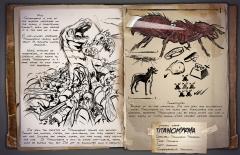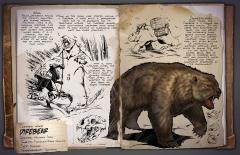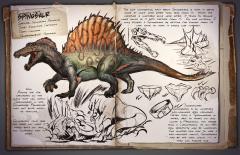Search the Community
Showing results for tags 'territorial'.
-
The Kosmoceratops has countless abilities that involve paint. For example, when you feed the Kosmoceratops paint it will a new ability to the dinosaur for a certain amount of time: 1: Red paint will boost your tamed creatures around you by 10% Lasts two minuets 2: Yellow paint will provide tamed creatures with a 20% defense against wild creatures Lasts two minuets 3: Blue paint will provide tamed creatures with a 25% gathering efficiency Lasts five minutes 4: Green paint will provide your Kosmoceratops with a poisonous bite which allows you to knock out wild creatures Lasts five minuets 5: Purple paint will provide your Kosmoceratops with a 10% crafting skill bonus to creatures and players around you. Lasts two minuets Taming To tame your very own Kosmoceratops you would have to make a certain amount of lazarus chowder depending on the level of the creature you find. 1. you would have to feed the creature 1 lazarus chowder for levels 1-20 2: you would have to feed the creature 5 lazarus chowder for levels 21-50 3: you would have to feed the creature 10 lazarus chowder for levels 51-100 4: you would have to feed the creature 15 lazarus chowder for levels 100 and up Once you have fed the creature the correct amount of lazarus chowder you will have to complete a minigame in order to fully tame it. To complete the minigame you have to collect from the correct bush that matches what the Kosmoceratops is craving. The way you know what bush to collect from, you will have to look above all the bushes in the area and the bush berries icon will show up. Special Abilities The Kosmoceratops can use its tail as cannon. Furthermore, if you put crystals in its inventory, you must press the attack button, trigger, etc. Moreover, it will shoot out a crystal cannon ball that can destroy structures up to the metal tier. Also, this attack can knock out karkinos and rock elementals (Each crystal cannon ball requires 100 crystals and 10 cementing paste to make). Also, the horns of a tamed Kosmoceratops can be used as a type of musical instrument which can be used to boost your herbivores defense and damage by 5%. However, if you use a wild Kosmoceratops horn, it will make the wild creatures around you become hostile towards you. (Horns break off over time and grow back) Common Name: Kosmoceratops Species: Kosmoceratops Richardsoni Time: Late Cretaceous Diet: Herbivore Temperament: Territorial
-
- rideable
- territorial
-
(and 3 more)
Tagged with:
-
From the album: Dossiers
Common Name: Titanomyrma Species: Titanomyrma parvagigan Time: Paleogene Diet: Herbivore Temperament: Territorial Wild: Titanomyrma is one of the smaller creatures on the island; A frightening thought, when you realize it is the size of a dog. A hive-minded herbivore, Titanomyrma usually goes about it's business unless provoked. When attacked or threatened, it releases a chemical which alerts all Titanomyrma in a large range to help fight the aggressor. I've seen two varieties of Titanomyrma: Drones and soldiers. Drones are smaller, faster and land-bound, and they harvest for the hive. Soldiers are larger, slower and have wings; They defend the hive. If Titanomyrma is akin to other hive-insects, there must be Queens too, but I've yet to encounter such a variant. Domesticated: Because of its hive mentality, I've not seen any successfully tamed Titanomyrma on the island yet. Fortunately for lone survivors, separated Titanomyrma can be easily picked off for a small supply of Chitin among other valuable natural resources.- 1 comment
-
- titanomyrma
- ant
- (and 7 more)
-
From the album: Dossiers
Common Name: Direbear Species: Arctodus Dirus Time: Mid Pleistocene / Early Holocene Diet: Omnivore Temperament: Territorial Wild: Found primarily among the Island’s mountain and tundra regions, Arctodus Dirus is an imposing creature. Like most of the creatures, that inhabit this island’s colder areas, it is a mammal, and this particular mammal is either at or near the top of that region’s food chain. Many on the island have started calling it Direbear, a name which appropriate both due to it’s enormity and it’s territorial nature. The Direbear ignores most non-hostile creatures while going about its daily routine of scavenging for meat and edible plantlife... That is, until intruders enter the territory it considers its own, at which point it viciously attacks. Most often, it is smartest to just run from an angry Direbear. Domesticated: Once tamed, the Direbear is a strong and reliable mount. it can carry vast quantities of goods, and can sprint for extremely long, nearly infinite periods. It is not the fastest creature from a hard stop, but after building up momentum, its sustained overland speed builds to among the best on the island. Of course, being able to feed a Direbear both meat and plantlife makes keeping one fairly convenient regardless of the environment. -
From the album: Dossiers
Common Name: Gigantopithecus Species: Gigantopithecus fibrarator Time: Pleistocene Diet: Herbivore Temperament: Territorial Wild: Gigantopithecus fibrarator is a strange creature. It is usually quite passive, but it has a very short temper when it comes to its personal space. Once another creature gets close, this gentle giant quickly becomes a rampaging beast. Best to give them a wide berth. Gigantopithecus seems most happy to lazily lay about, picking berries from plants. Many Gigantopithecus spend much of their day in one small area unless they are provoked. Domesticated: In addition to being at home picking berries a tamed Gigantopithecus can be taught to harvest the fibers found on many island plants as well. It appears to be entirely content to pick at plants all day, eat the berries, and hold the fibers for its tribe. Playful once tamed, Gigantopithecus seems to enjoy throwing its shoulder-mounted rider into the air. It probably feels this is a game, but clever brigands can use this "game" to vault over walls and small cliffs.-
- gigantopithecus
- ape
-
(and 8 more)
Tagged with:
-
From the album: Dossiers
Common Name: Spino Species: Spinosaurus aquareliga Time: Early-Late Cretaceous Diet: Carnivore Temperament: Territorial Wild: Among the carnivores on the Island that can match Tyrannosaurus in size, Spinosaurus aquareliga does not quite match its ferocity. Spinosaurus four legs and large sail make it fairly swift on land, and incredibly fast in water. The one comforting fact about Spinosaurus is that it seems more at home near water than away from it. While the creature is insatiable while near water, it tends to become more docile as it gets further away from it. On one occasion, I only escaped a Spinosaurus by getting far enough from its lake home to make it simply lose interest. Domesticated: Spinosaurus is an incredibly well-rounded apex carnivore. Faster than a Tyrannosaurus in water, able to travel on land unlike a Megalodon, and larger than a Carnotaurus, its all-terrain versatility may be unrivaled. For hunters who wish to have a well-rounded mount, Spinosaurus may be the ideal choice—If they can acquire one.-
- territorial
- carnivore
-
(and 5 more)
Tagged with:




